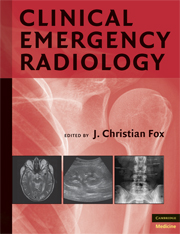Book contents
- Frontmatter
- Contents
- Contributors
- PART I PLAIN RADIOGRAPHY
- PART II ULTRASOUND
- 12 Introduction to Bedside Ultrasound
- 13 Physics of Ultrasound
- 14 Biliary Ultrasound
- 15 Trauma Ultrasound
- 16 Deep Venous Thrombosis
- 17 Cardiac Ultrasound
- 18 Emergency Ultrasonography of the Kidneys and Urinary Tract
- 19 Ultrasonography of the Abdominal Aorta
- 20 Ultrasound-Guided Procedures
- 21 Abdominal—Pelvic Ultrasound
- 22 Ocular Ultrasound
- 23 Testicular Ultrasound
- 24 Abdominal Ultrasound
- 25 Emergency Musculoskeletal Ultrasound
- 26 Soft Tissue Ultrasound
- 27 Ultrasound in Resuscitation
- PART III COMPUTED TOMOGRAPHY
- PART IV MAGNETIC RESONANCE IMAGING
- Index
- Plate Section
23 - Testicular Ultrasound
from PART II - ULTRASOUND
Published online by Cambridge University Press: 07 December 2009
- Frontmatter
- Contents
- Contributors
- PART I PLAIN RADIOGRAPHY
- PART II ULTRASOUND
- 12 Introduction to Bedside Ultrasound
- 13 Physics of Ultrasound
- 14 Biliary Ultrasound
- 15 Trauma Ultrasound
- 16 Deep Venous Thrombosis
- 17 Cardiac Ultrasound
- 18 Emergency Ultrasonography of the Kidneys and Urinary Tract
- 19 Ultrasonography of the Abdominal Aorta
- 20 Ultrasound-Guided Procedures
- 21 Abdominal—Pelvic Ultrasound
- 22 Ocular Ultrasound
- 23 Testicular Ultrasound
- 24 Abdominal Ultrasound
- 25 Emergency Musculoskeletal Ultrasound
- 26 Soft Tissue Ultrasound
- 27 Ultrasound in Resuscitation
- PART III COMPUTED TOMOGRAPHY
- PART IV MAGNETIC RESONANCE IMAGING
- Index
- Plate Section
Summary
INDICATIONS
Testicular ultrasound has emerged as the imaging modality of choice for any patient with testicular or scrotal complaints (1). Triplex ultrasound—the combination of three ultrasound modes, including gray scale ultrasound, color Doppler imaging (CDI), and spectral Doppler imaging (SDI) — has proven highly sensitive, specific, and repeatable in the detection of acute and chronic testicular diseases (2).
The primary indication for testicular ultrasound is acute scrotal or testicular pain. The most common etiologies of acute scrotal pain are epididymitis, orchitis, testicular torsion, and scrotal trauma (1). Additional indications for testicular ultrasound include, but are not limited to, hematuria, dysuria, a palpable testicular/scrotal mass, and infertility.
As with the diagnostic approach for any organ system or complaint, pertinent historical features aid the health care provider in creating a differential diagnosis based on patient age, risk factors, symptom onset, duration, and quality. Most disease states for the testicle present acutely, including epididymitis, orchitis, testicular torsion, and testicular trauma. The most time-critical diagnoses include testicular torsion and testicular rupture because testicular salvage and fertility are inversely related to time to surgical repair from disease onset. In general, testicular function is recovered when surgery is performed within 6 hours from symptom onset (1). The incidence of testicular torsion is greatest in those 6 to 15 years of age and decreases significantly after 25 years of age.
Keywords
- Type
- Chapter
- Information
- Clinical Emergency Radiology , pp. 330 - 336Publisher: Cambridge University PressPrint publication year: 2008
- 2
- Cited by

